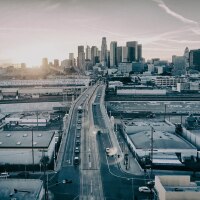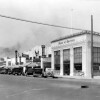
L.A.'s 'Black Beverly Hills' Still Threatened by Racist Past
The 1920s subdivision of View Park earned its nickname the "Black Beverly Hills" by becoming one of the largest, wealthiest and most architecturally distinct Black neighborhoods in Los Angeles. In 2016, it was added to the National Register of Historic Places due to its ethnic heritage and architectural integrity. But it owes its significance to a complicated racial history. At its inception, anyone not of the Caucasian race was forbidden from owning or occupying properties in View Park due to racial deed restrictions. After this practice was outlawed by the Supreme Court in 1948, affluent Black families began to move into the neighborhood. By the 1980s, following an onslaught of racial antagonism and violence — and eventual white flight — the Black population of View Park outnumbered the white population nine to one.
Today, racial turnover still threatens View Park. Prior to its listing, residents debated the value of historic recognition. Many feared that the national title would cause an influx of new populations, an escalation in prices and a disruption of Black residents' hard-earned community identity. Cohesive neighborhood planning and aesthetics may have earned View Park a national title, but these characteristics were initially sequestered for the benefit of white populations. In the early twentieth century, neighborhoods where Black families were not forbidden from owning or occupying property did not commonly feature modern improvements such as underground utilities or wide lot frontages like those at View Park. Without community investments to support an increase in property values, L.A.'s Black neighborhoods were more susceptible to decline, influencing sustained housing insecurity for Black populations in Los Angeles. The national recognition of View Park commemorates the racial progress made during the Civil Rights Era, but racial inequalities still underlie its character.

View Park was planned, subdivided and built by the Los Angeles Investment Company (LAIC) from the 1920s to the 1950s. LAIC was formed at the turn of the century to purchase and subdivide land and design, finance, build and sell homes across Los Angeles. Though its original directors were indicted for overspeculation and fraud in 1913, the Supreme Court ruled in favor of the continuation of LAIC under new direction. After much litigation, J.E. Fishburn, President of the National Bank of California; L.A. Times publisher: Harry Chandler; real estate lawyer, Henry O'Melveny; and William Allen Jr., President of the Title Insurance and Trust Company, were selected to transition the company. With their respective influences, the new directors were posed to carry out the largest of LAIC's endeavors: a contract to purchase lands in the Baldwin Hills. After years of negotiations and refinancing, LAIC obtained the lands and began subdividing what would become View Park in 1924 under the direction of its new President, Reuben Ingold.
Plans for View Park aligned with the projected interests of the Los Angeles Chamber of Commerce, City Planning Commission and Realty Board. These agencies publicized their beliefs that homogenous subdivisions with deed restrictions would prevent decline in property values. Suggested restrictions included both aesthetic and racial characteristics. LAIC selected the beautiful hilltop site of their Baldwin Hills property for the development of a fully improved, white-only subdivision in accordance with these beliefs. By widening Crenshaw and Slauson Boulevards, laying underground utilities, paving the streets and lining them with sidewalks, trees and street lamps, LAIC ensured the creation of a modern, fully-improved neighborhood; by establishing wide lot frontages (60 to 100 feet on average) and minimum home prices ($7,500 and up), LAIC ensured an upper-class population; and by providing model homes and an Architectural Review Board, LAIC ensured cohesive and distinctly residential architectural character throughout.
LAIC established a homogenous community by celebrating Los Angeles' colonial past with the design of the neighborhood. After subdividing and improving the site, LAIC built several modern, Spanish-style homes to set the character. Spanish and Mission Revival architecture echoed the structures built by Spanish colonizers in their conquest of California. LAIC homes were adorned with stucco walls, clay tile roofs, cylindrical entry towers, carved wooden doors, ornamental beamed ceilings and wrought iron balconies. The homes were given names like "The Barcelona" and "The Peyolas" to support this vision. View Park was said to contain sites like those that may be "found in the "better home" district in Barcelona, Spain and overlooking the Mediterranean. The identities of African and Indigenous Mexican and American populations who founded and helped build Los Angeles were hidden behind Spanish Revival aesthetics and rhetoric.

Perhaps the most influential restriction was LAIC's requirement that all properties have deed restrictions to prevent anyone "not of the Caucasian race," considered "detrimental influences," from owning or occupying the land. The Supreme Court supported this practice in their decision in the 1919 LAIC case against Alfred Gary, an African American man who had purchased a home in one of LAIC's restricted subdivisions. The court ruled that although the Fourteenth Amendment protected Black ownership of property, it did not prevent developers from restricting the Black occupation of property through deed restrictions.
With the Establishment of the National Housing Act in 1934, View Park became the first subdivision in Southern California to receive insurance from the Federal Housing Administration (FHA). FHA insurance provided homeowners with long-term amortized mortgages and developers with financial incentives and protection against homeowner loan defaulting. As Richard Rothstein outlines in "The Color of Law," these offerings of security were only made available to white persons and to developers for properties with racial deed restrictions in place. View Park was insured as a national example of the kind of property expected to experience sustained values due to its homogenous racial composition and cohesive residential aesthetics.

It wouldn't be until the Supreme Court's ruling in the 1948 case of Shelley v. Kraemer that racial deed restrictions would be revoked, and even then, Black families were met with extreme racial violence as they moved into neighborhoods previously reserved for white people. In 1969, Andre Vaughn, the African American owner of the First Security Investment Company, began selling properties to Black families in View Park. The weekend after Dr. Piper moved into his new home at 4915 South Verdun, white neighbors burnt a cross on his lawn. Though affluent Black families were able to enjoy the benefits of fully improved subdivisions like View Park after the 1960s, their experiences have been marred by the continuation of racist acts. At the 2018 L.A. Commons symposium titled "Evolution of View Park," a community member explained how white "gentrifiers" police the neighborhood for violations to report, causing Black residents to feel harassed. Citizen policing and racial profiling are a danger to Black people in the suburbs; or worse: fatal, as was the case for Ahmaud Arbery, who was shot to death while jogging by white neighbors who believed him to be a criminal based on his race.
Today, racialized housing inequalities are pervasive, if less overt. During the decade of View Park's greatest demographic shift (1960 to 1970), median property values increased by only 30% compared with the city average of 54%. According to the U.S. Census data white neighborhoods appreciated $200,000 more on average from 1980 to 2015 compared with non-white neighborhoods. As white people are priced out of appreciated neighborhoods, demand grows in those like View Park that have not experienced commensurate spikes in property values. In fact, from 2010 to 2020, the Black population of View Park dropped from 85% to 78%, suggesting that residents' fears of gentrification are not unfounded. The "Reuben Ingold Park" at the northwest edge of View Park is named for the racist real estate developer behind its development. Despite the successful transformation of View Park into the "Black Beverly Hills," its racist past lingers in the fine print.
Sources
Clary, William W. 1966. "Los Angeles Investment Company" in History of the Law Firm of O'Melveny & Myers, 1885-1965 Volume I. Los Angeles: O'Melveny & Myers.
Howell, Junia and Elizabeth Korver-Glenn. 2020. "The Increasing Effect of Neighborhood Racial Composition on Housing Values, 1980–2015." Social Problems spa 033, Sept 04.
Jennings, Angel. 2015. "'Black Beverly Hills' Debates Historic Status vs. White Gentrification" Los Angeles Times, July 18. Accessed at: https://www.latimes.com/local/la-me-adv-view-park-20150719-story.html
Thomas, Fred. 2018. "Racism: White Flight: Gentrification-A Discussion about View Park and Surrounding Communities." Thomas Reports, May 12. Accessed at: https://thomasreports.org/2018/05/12/racism-white-flight-gentrification-a-discussion-about-view-park-and-surrounding-communities/
U.S. Department of the Interior, National Park Service. 2016. View Park Historic District No. 1024-0018, July 12. https://www.nps.gov/nr/feature/places/pdfs/16000434.pdf
Editor's note: This article was updated to reflect that the case that struck down the enforcement of racially restrictive covenants in property deeds was Shelley v. Kraemer (1948) and not Plessy v Ferguson (1896).









